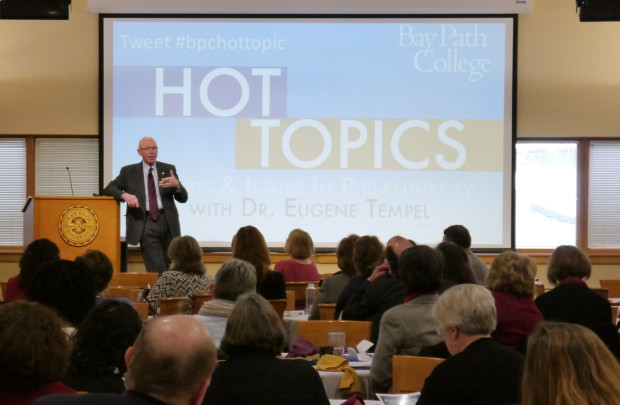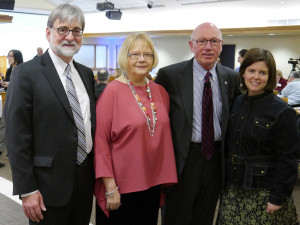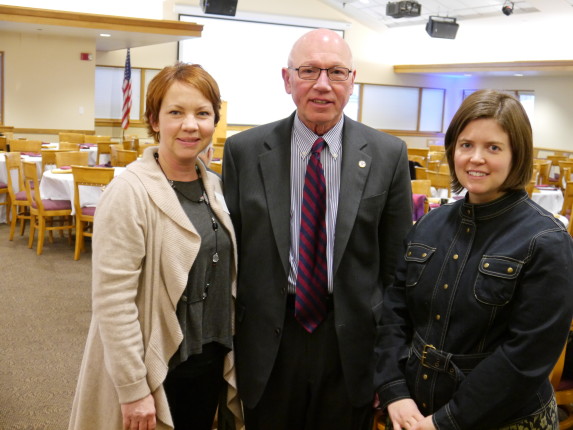
Image Courtesy of Bay Path College
On Jan. 10, 2014 I had the opportunity to attend the Hot Topics Breakfast Series: Trends & Issues in Philanthropy featuring keynote speaker Dr. Eugene R. Tempel at Bay Path College in Longmeadow, MA.
Dr. Gene Tempel is the Founding Dean of Indiana University Lilly School of Philanthropy and is a national leader and recognized expert on philanthropic fundraising. He was invited to speak by his former graduate assistant, Dr. Sarah K. Nathan, who is now Assistant Professor, Nonprofit Management and Philanthropy, School of Management and Social Justice at Bay Path College.
After the keynote, I had the pleasure of meeting with Dr. Tempel while he allowed me to pick his brain and share, here, insights he’s gained over the past 30 years in the field with you, dear readers.
3ST: In ’87 there were 900,000 registered nonprofit organizations and today there are about 1.4 million. Do you see any trend for nonprofits to collaborate, even merge?
Dr. Tempel: This is one of the most interesting questions and there are a lot of aspects around those total numbers.
First let me give you what I think are one of the points of contention in this. First, there is the notion is that every person has a right to start a nonprofit organization. On the other side, it’s not every person’s obligation to support that organization.
So part of this includes the freedom of expression and what’s right in democracy: your right to create the organization. So, if you start limiting the number of organizations, and there have been some attempts to do that, you are actually putting a damper on freedom of expression.
Another aspect of this is that many of the organizations actually go out of existence without anyone knowing. The numbers in the question represent what is on the books. But the data is not always reflective of the current status For example, there are groups listed as having 501c3 status that are no longer operating.
Collaboration and merging became a very hot topic in the late 90’s; less so today. The potential problem is that even with organizations delivering very similar services, there might be very different philosophical perspectives. So trying to get those organizations to merge as one can be quite problematic. The easiest thing to do is to work on back office collaborations and support….computer services, accounting services, printing and so forth. You might take 10 small arts organizations, put them in the same building, same CFO, etc., down the line. This is less problematic because what they really care about is what happens in the front office. Then they are all being supported by this highly efficient operation and you gain economies of scale as a result. And some of that has happened. For example, I met a woman who works with a number of organizations to help with their grant proposals and administration— she’s a consultant, yes, but it’s like a form of collaboration because these organizations might only need those services 10% of the time.
I’m in favor of collaboration. I’m also in favor of mergers when that makes sense. Typically, the boards are the stumbling block there, as are the philosophical differences that need to be mediated for it to work.
The other part of your question revolves around growth. What’s bothersome about the growth of nonprofit organizations is that giving remains at 2% of GDP. It has not increased with the increase in the number of organizations. What increases is the amount of money going to philanthropy. Now, some would argue that GDP is not a fair measure. GDP includes everything. So what philanthropy is competing with today is with people getting their nails done, buying cell phones, going to restaurants and other uses of discretionary income. You can see all this consumption going on in the US economy that’s all part of GDP.
Well, every time I get my lawn mowed by someone, that becomes part of GDP. We caused GDP to grow. Part of the reason philanthropy is growing is because GDP has grown so much. People get frustrated because it’s still at 2% of GDP, but it’s 2% of a much larger, complex economic picture than we had 25 years ago.
Do I sound like an economist? It comes down to this: People give because they get engaged. And the more organizations that do a really good job of engaging people the better chance we have of expanding philanthropy.
3ST:When you talk about mergers, it sounds like that involves some advanced financial aptitude. Are most nonprofits equipped for the fiscal know-how required in a merger?
Dr. Tempel: No, many nonprofits simply don’t have people with that background. But if they don’t, they should have them on their board. It should become a priority in how they recruit board members.
3ST: How did you first become aware of philanthropy and what led you to become a part of it?
Dr. Tempel: All of us should do our own, what I call Philanthropic Biography. How did you become aware of the significance of philanthropy.
Personally, I remember, like many, giving money in the collection tray at church when I was a child. But I didn’t really think much about it until the day our house burned down. Then I realized that the volunteer fire department and the people who provided food and clothing where part of philanthropy and that was a memorable experience for me.
Later, when teaching English at a college, which I loved doing, I was approached to help take over this campus that they had. I finally agreed to do it, because they convinced me that if I didn’t that it wouldn’t ever happen. But, there was this group of businessmen in the community who wanted the campus there and they somehow knew how to raise money. So I met every Friday with these guys and they had a gift range chart—a whole system. I went out with them on all of the fundraising visits and became fascinated with it. Fundraising, at that point had, for many, the connotation as being an awful activity. But I found it fascinating. Somehow, I took the challenge.
After ten years of working as an administrator in community colleges, I went to work at Indiana University College of Arts and Sciences to raise money. And the more I got into it, the more fascinated I became with the whole process. To understand why people gave, how you get organized. So, for me, one thing led to another.
Going to The Fund Raising School, for me, was a transforming experience. To see there was actually a system: a process, and that giving was a rational process. And then we started the Center (on Philanthropy); I just made it my life to understand philanthropy as a part of our society. People think it only exists in the US, but every part of the world has some form, although it is more formally developed in the US because of the separation of church and state.
I just got back from China. The Chinese government has now sanctioned “Fundraising Manager” and “Association Manager” as two professional positions in their system. I think it’s the first country in the world to have formal designations to recognize those positions. They decided, in their last congress, that much of what they will do to improve the social sector in China will be done through philanthropy.
3ST: What advice do you have for those starting out or changing careers to fundraising?
Dr. Tempel:Fundraising requires a unique combination of the ability to pay attention to detail and an ability to reach out, understand, show empathy for and engage people. Those qualities don’t always exist everyone, but for fundraising they really need to.

Professor Jeffrey Greim,Provost Dr. Morriss-Olson, Dr. Tempel, Dr. Nathan
Image Courtesy of Bay Path College
I had someone say to me, “I thought fundraising was just going to lunch with people.” Well no, it’s not. That’s the visible part of it, but it takes paying attention to detail and being able to commit to a management structure that helps engage donors over time. And engaging is not an easy job!
I think if you want to work in fundraising and be successful, you need to be committed to the cause and advancing it. That’s transformational.
When people come to me and say they want to move into the nonprofit sector the first thing I ask them is “What are you really passionate about?” Because it’s easier to be a fundraiser if you are working for a cause you believe in. And if you are doing it merely as a “job”, then you end up becoming part of a transactional system rather than a transformational one that can make change. I think of fundraisers like missionaries: You get energized by the cause you are associated with.
If you just want to work for a nonprofit and aren’t committed to the cause, you will probably end up finding yourself in a position of feeling like you’re pushing a product: making it merely transactional.
There are people who just can’t handle it and cant’ do it. I think of fundraising as more than just a job, but a way of life.


Pingback: Indiana University Lilly Family School of Philanthropy Announces New Dean - Third Sector Today()
Pingback: Indiana University Lilly Family School of Philanthropy Announces Pasic New Dean - Third Sector Today()